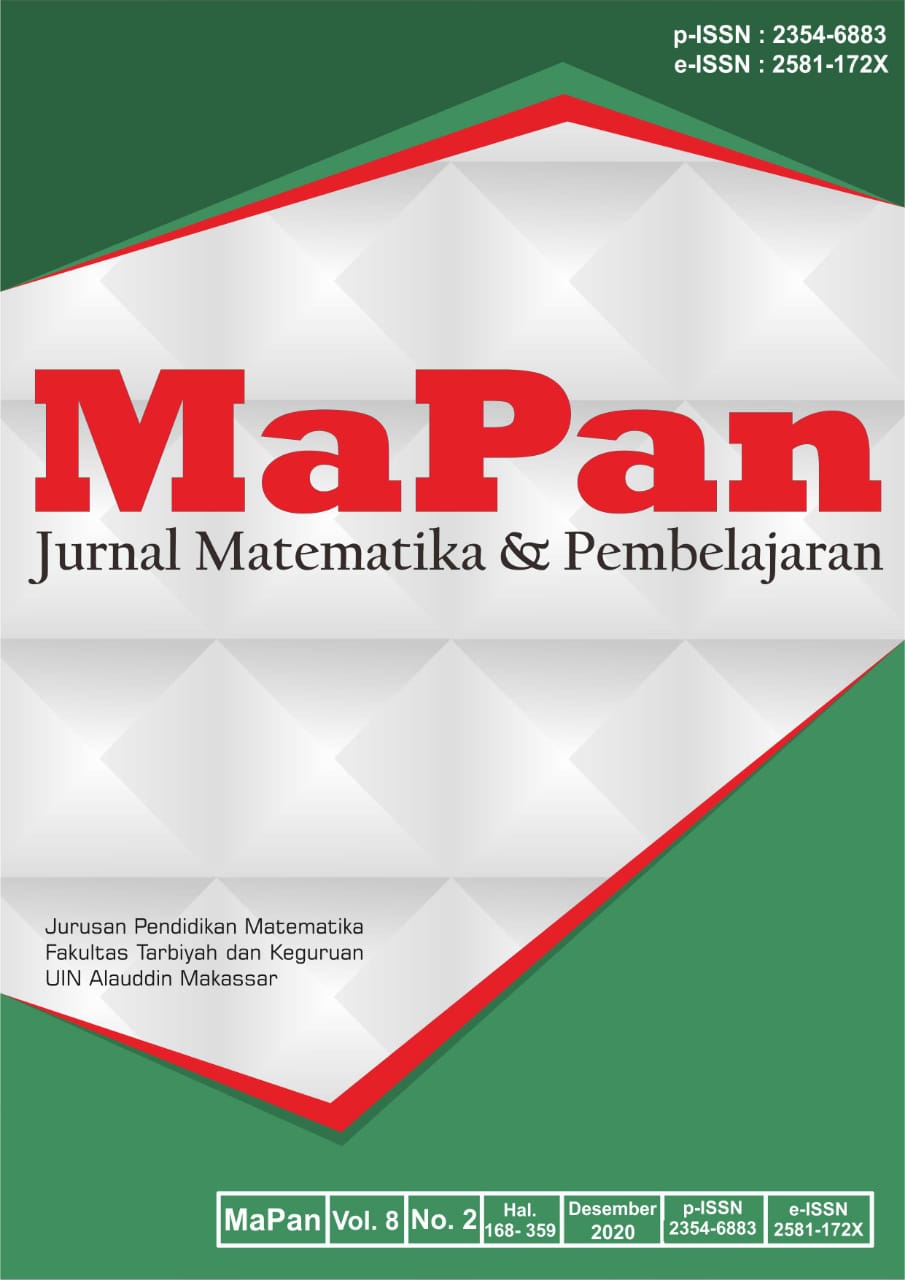WRITTEN MATHEMATICAL COMMUNICATION SKILLS ON OPEN-ENDED PROBLEMS: IS IT DIFFERENT BASED ON THE LEVEL OF MATHEMATICS ABILITY?
Abstract
This study aims to describe students' written mathematical communication skills in open-ended problems based on their mathematical abilities. This research was conducted at grade VII-A of SMPN 1 Pamekasan. This research uses descriptive qualitative research. The instruments used were the Mathematical Ability Test (MAT), Written Mathematical Communication Skills Test (WMCST) on open-ended problems, and Interview Guidelines. The results showed that subjects with high and moderate mathematical ability were able to meet three indicators of written mathematical communication skills, namely being able to express mathematical ideas through writing, demonstrate and convey visually; able to understand, interpret and evaluate mathematical ideas in writing, as well as in other visual forms; and able to use mathematical notations in the structure to write down ideas and relationships with situation models in writing. Meanwhile, subjects with low mathematics ability can fulfill 2 out of 3 indicators of written mathematical communication skills, namely being able to express mathematical ideas through writing, demonstrate and convey visually; unable to understand, interpret and evaluate mathematical ideas in writing or other visual forms; and able to use mathematical notations in the structure to write ideas and relationships with situation models.Downloads
References
Agustyaningrum, N. (2011). Implementasi model pembelajaran learning cycle 5E untuk meningkatkan kemampuan komunikasi matematis siswa kelas IX B SMP Negeri 2 Sleman. Prosiding Pada Seminar Nasional Matematika dan Pendidikan Matematika dalam Pembelajaran dengan Tema Matematika dan Pendidikan Karakter dalam Pembelajaran. Yogyakarta: Pendidikan Matematika FMIPA UNY.
Ansari, B. (2003). Menumbuh kembangkan kemampuan pemahaman dan komunikasi matematika siswa melalui strategi Think-Talk-Write. Yogyakarta: Pustaka Pelajar.
Burghes, D., & Robinson, D. (2009). Lesson study: enhancing mathematics teaching and learning. Plymouth UK: CfBT Education Trust, University of Plymouth.
Fraenkel, J., Wallen, N., & H., H. (2008). How to design and evaluate research in education. New York: Mc Graw Hil I Companie.
Guerreiro, A., & Serrazina, L. (2009). Communication as social interaction primary school teacher practices. Proceedings of the Sixth Congress of the European Society for Research in Mathematics Education. Lyon, France.
Hardjana, A. M. (2003). Komunikasi intrapersonal dan interpersonal. Yogyakarta: Kanisius (Anggota IKAPI).
Herdiana, H., Rohaeti, E. E., & Sumarmo, U. (2017). Hard skills dan soft skills matematika siswa. Bandung: PT. Reflika Aditama.
Herdiana, H., Rohaeti, E. E., & Sumarmo, U. (2018). Hard skills dan soft skills matematika siswa (Cetakan Kedua). Bandung: PT Rafika Aditama.
Inprasitha, M. (2006). Open-ended approach and teacher education. Tsukuba Journal of Educational Study in Mathematics, 27, 169–177. http://www. human.tsukuba.ac.jp/-mathedu/2514.pdf/.
Kaya, D., & Aidin, H. (2014). Elementary mathematics teachers’ perceptions and lived experiences on mathematical communication. Eurasia Journal of Mathematics, Science & Technology Education, 12(6), 1619–1629. https://doi.org/10.12973/eurasia.2014.1203a.
Majid, A. (2016). Strategi pembelajaran (edisi VI). Bandung: PT Remaja Rosdakarya.
Nastahwid, M., Irawan, E. B., & Susanto, H. (2016). Kemampuan komunikasi matematis siswa dalam pembelajaran sistem persamaan linear dua variabel menggunakan masalah open ended. Prosiding Pada Seminar Nasional Matematika Dan Pembelajarannya. Universitas Negeri Malang, Malang.
NCTM. (2020). Principles and standards for school mathematics. Reston VA: The National Council of Teachers of Mathematics, Inc.
Qohar, A. (2011). Pengembangan instrumen komunikasi matematis untuk siswa SMP. Prosiding Pada LSM XIX Lomba Dan Seminar Matematika. Pendidikan Matematika FMIPA Universitas Negeri Yogyakarta, Yogyakarta.
Romadhon, S. (2016). Analisis kemampuan komunikasi matematis siswa SMP pada materi kubus dan balok. Ekuivalen - Pendidikan Matematika, 20(3), 167–172. https://doi.org/10.37729/ekuivalen.v20i3.2893.
Suherman, E., Turmudi, D. S., Herman, T., & Suhendra, S. P. (2001). Strategi pembelajaran matematika kontemporer. Bandung: JICA-UPI.
Susanto, A. (2013). Teori belajar dan pembelajaran. Jakarta: Kencana Prenadamedia Group.
Syafitri, E., Saragih, E. M., & Astuti, D. (2018). Mathematics learning by using learning model tapps to improve students’ mathematical communication skill. The 11th International Workshop and Conference of Asean Studies in Linguistics, Islamic and Arabic Education, Social Sciences and Educational Technology 2018. https://doi.org/10.31227/osf.io/3fcqm.
Wijaya, H. P. I., Sujadi, I., & Riyadi. (2016). Kemampuan komunikasi matematis siswa sesuai dengan gender dalam pemecahan masalah pada materi balok dan kubus (studi kasus pada siswa SMP kelas VII SMP Islam Al-Azhar 29 Semarang). Jurnal Elektronik Pembelajaran Matematika, 4(9), 778–788. http://jurnal.fkip.uns.ac.id/index.php/s2math/article/view/9654/7105.
Zuhrotunnisa. (2015). Deskripsi kemampuan komunikasi matematis siswa MTs. Negeri Bojong pada materi statistika. AlphaMath: Journal of Mathematics Education, 1(1), 1–12. https://doi.org/10.30595/alphamath.v1i1.209.
Copyright (c) 2020 Septi Dariyatul Aini, Moh. Zayyadi, Kuratul Aini Saleh

This work is licensed under a Creative Commons Attribution 4.0 International License.


